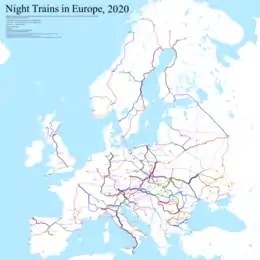EuroNight
EuroNight, abbreviated EN, is a European train category which denotes many main-line national and international night train services within the Western and Central European inter-city rail network.

Overview

The classification and name were brought into use in May 1993.[1] Unlike the equivalent day-running counterparts EuroCity and InterCity trains, the EuroNight trains tend to run during the nighttime and are equipped with various cars for accommodating sleep services. Nearly all EuroNight trains require reservations and additional fare-supplements in addition to the regular cost of a ticket from the destination to the arrival point. These supplements vary in price depending on whether the traveler wishes to sit in a regular seat, a couchette "lying bed" which offers a padded, felt bed with a blanket and small pillow, or a sleeping bed which allows a mattress bed with full bedding (sheets, comforters, pillows).
Nearly all EuroNight services are international services (though a few large nations, including France and Germany, operate EN services nationally) and are jointly operated by various national rail companies, with many rail companies sharing cars on the route. EN trains developed and became the standard night-train service for all Western and most Central European nations, receiving special designation from the older D-Nacht services (many of which still operate in Central and Eastern Europe). EN trains have special criteria that rail companies must match in order to receive the EN designation.
Train numbers follow the EN designation. Many routes also have accompanying names that originally designated the route in the 19th and 20th centuries (EN 264 still operated on the classic Orient Express route from Vienna to Strasbourg, until its cancellation and withdrawal in 2009 for example).
Operating carriers
The following carriers currently have designated cars and train conductors who work the EN lines. Many railway companies share cars on the same train line between routes; for example, EN 235 between Vienna and Rome share cars of both the ÖBB and Trenitalia.
- Austria's ÖBB (introducing in December 2016 its Nightjet-Services)
- Croatia's HŽ
- Czech Republic's ČD
- France's SNCF (as part of their Intercités de nuit brand)
- Germany's DB (as part of their City Night Line brand; shut down by December 2016)[2]
- Hungary's MÁV
- Italy's Trenitalia
- Luxembourg's CFL
- Netherlands, The NS Hispeed[3]
- Poland's PKP Intercity
- Romania's CFR
- Slovakia's ZSSK
- Spain's Renfe Operadora
- Sweden's Veolia Transport
- Switzerland's SBB
Deutsche Bahn operated the additional City Night Line hotel-quality night services between Germany, Italy, the Czech Republic, Switzerland, and The Netherlands. Two of those, the Kopernikus and the Canopus, are designated EuroNight trains as EN 458/459. However, Deutsche Bahn terminated all of its own night train services by December 2016.[2]
List of EuroNight trains
See also
References
- "International Services from May 23" (changes taking effect). Thomas Cook European Timetable (May 1–22, 1993 edition), p. 3. Peterborough, UK: Thomas Cook Publishing.
- DB to withdraw all remaining sleeper trains 21 December 2015
- "EuroNight to Copenhagen, Prague, Moscow". Dutch Railways NS. 2012-10-09. Retrieved 2012-10-09.
- "Archived copy". Archived from the original on 2015-03-20. Retrieved 2014-11-02.CS1 maint: archived copy as title (link)